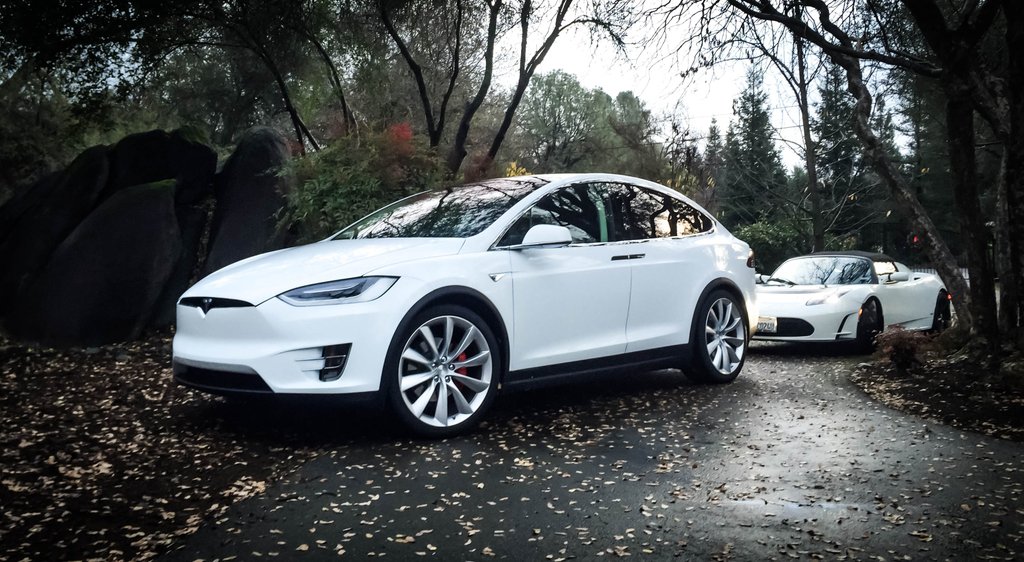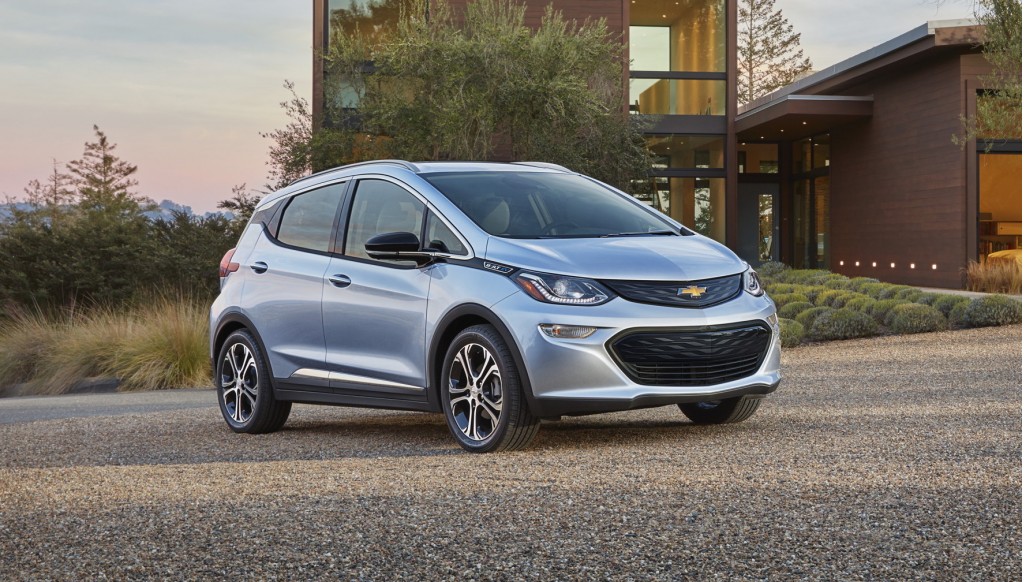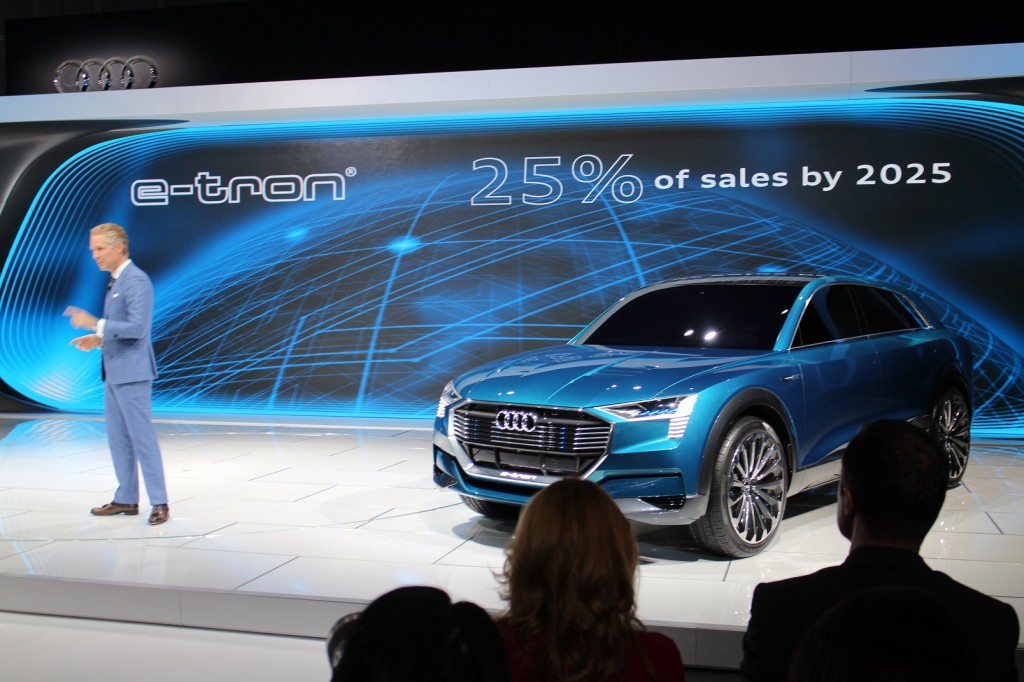Five years after the first mass-market electric car hit the market, cars with plugs haven't lived up to the most optimistic projections for their adoption.
They are at least pacing the rate of hybrid cars over their first five years, but numerous factors have challenged what advocates see as an obvious evolution.
Many of those challenges reside in the automakers themselves, many of which still largely view plug-in electric cars as a necessary regulatory evil rather than a new product category.
DON'T MISS: Is Chevy Bolt EV's Main Mission To Marginalize Tesla Electric Cars?
Green Car Reports was recently quizzed by an auto-industry analysis firm about its views on the next five years of plug-in cars.
After a conversation, we decided to expand that discussion into a full-blown article.
What follows is our assessment of the six most important trends (some admittedly closer to predictions) that will govern the electric-car segment between now and 2020.

2016 Tesla Model X with 2011 Tesla Roadster Sport, photographed by owner Bonnie Norman
(1) Everything gets more range
The Tesla Model 3 was described years ago as a 200-mile electric car to sell for $35,000, but the date for actual launch remains murky at best. Tesla has said it'll start production at the end of next year; analysts remain skeptical.
The 2017 Chevrolet Bolt EV, on the other hand, will be rated at 200 miles and cost $37,500--and GM will ensure that it goes into production by the end of this year.
That will force Nissan, BMW, Volkswagen, and others to keep pace, adding 200-mile capability to their mass-market battery-electric vehicles.

2017 Chevrolet Bolt EV
Within three years, we expect 150 to 200 miles to become the new normal for all-electric cars priced at $30,000 to $45,000, perhaps lower.
Similarly, we now have a raft of new (and mostly low-volume) plug-in hybrids with ranges of 15 to 24 miles.
At the moment, they're largely to tick the Chinese-market box that lets them qualify for all the incentives given to New Energy Vehicles--even if they're never, ever plugged in.
ALSO SEE: All Those Plug-In Hybrid Models? They're For China, More Than The U.S.
But the 2016 Chevy Volt has a real 53-mile range, which means nine of every 10 trips will be entirely on grid power.
Ranges of 40 to 60 miles are likely to become the benchmark for future generations of plug-in hybrids.
And those ranges have been most specifically telegraphed by BMW's Power eDrive system.

BMW 5-Series Gran Turismo Power eDrive prototype
(2) Mild hybrids will be supplanted by 48-Volt enhanced start-stop systems
With significant advances made in 48-Volt enhanced start-stop systems from a variety of suppliers, the era of the high-voltage mild hybrid has likely come to a close.
They were first launched by Honda minimalist 1999 Insight; it built a few million mild hybrids with motors of 10 to 20 kilowatts (13 to 27 horsepower). The challenge is the expense of a high-voltage battery pack and associated power electronics.
GM followed the mild-hybrid path as well, with two (not very successful) generations of its eAssist (nee Belt-Alternator-Starter) system--but conventional gasoline powertrains kept duplicating their fuel-economy figures at much lower cost.
So we expect that GM may join a number of European and North American makers in adopting cheaper 48-Volt enhanced "microhybrid" systems on a wide variety of models by 2020.

Lithium-ion cell and battery pack assembly for Nissan Leaf electric car in Sunderland, U.K., plant
(3) Lithium-ion chemistries will stay with us
While advanced battery chemistries and huge advances in energy storage density are alluring, slow, steady, incremental improvements in all facets of lithium-ion cells will power electric cars for at least the next 10 years.
Cell chemistries, anode and cathode materials, higher-yield fabrication processes, and economies of scale will all combine to continue the reduction in cost-performance that averages 6 to 8 percent a year.
And better-than-predicted improvements since 2010 have already brought large-format cells to a price of $145 per kilowatt-hour (if you believe repeated statements from GM's product chief Mark Reuss) when the 2017 Bolt EV launches late this year.
Change comes slowly. Note that Toyota still uses the nickel-metal-hydride battery packs it launched in its first hybrid 20 years ago.

Nissan Leaf ad
(4) Market understanding will (must) improve
Fuel prices get a lot of focus, but they're only one facet of the challenges facing sales of plug-in cars.
They only really apply to those buyers who assess a car based on its lifetime running costs--outside of fleet customers, a distinct minority of buyers.
Other motivations include early technology adoption, environmental awareness, preference for the car's driving experience, and a desire for energy independence from using imported oil.
READ THIS: Who Buys Plug-In Electric Cars, And Why? CA Report Explains It All For You
After five years, legacy makers have demonstrated a profound inability to understand who buys a plug-in car, why they might do so, and how to reach those people.
Worse, explaining the benefits of plug-in cars to buyers beyond early adopters requires them to point out the advantages--smooth, quiet operation and a low cost-per-mile--that would put the entire rest of their lineup at a disadvantage.
But the challenge of meeting regulatory requirements for sales of zero-emission car sales is now exacerbated by low oil prices that drive buyers all over the world to favor thirstier SUVs over passenger cars.

BMW i3 and Volkswagen e-Golf electric cars using Combined Charging System (CCS) DC fast charging
So the makers may have to sell more plug-in cars than they planned, even as regulations intensify starting in 2018.
Sooner or later, they will have to figure it out.
Not willingly, perhaps, but simply to stay compliant with carbon limits and fuel-economy laws now in place in most major world markets.
(5) Regulators will begin to look at actual electric miles driven
More than 50,000 Toyota Prius Plug-In Hybrids were sold from 2012 through last year, putting it among the five best-selling plug-in models.

2012 Toyota Prius Plug-In Hybrid - production model
But its 11-mile electric range on the U.S. EPA test cycle was provided by a powertrain so minimalist that the engine often switched on if the owner breathed too hard.
Toyota refused to release data on charging behavior, but it's widely assumed that many plug-in Priuses were sold in California only to get carpool-lane access--and never plugged in.
That would contrast with plug-in hybrids from Chevrolet, Ford, and other makers willing to release data on how often and how long their cars are actually plugged in.
CHECK OUT: Denise Gray, CEO Of Battery Maker LG Chem Power: Five Questions
Now the powerful California Air Resources Board in particular is starting to think about regulatory changes that would assign incentives based rated electric range or even proven usage of the cars on battery power alone.
If such changes take hold--and China would be well advised to do the same if it really wants to cut emissions--longer-range plug-in hybrids will get an additional push.
(6) Pervasive DC quick-charging networks are necessary
One of the toughest aspects of battery-electric cars for legacy makers to get their heads around is the idea that makers must ensure that a pervasive network of DC quick-charging stations is available for long-distance travel.
The idea that battery-electric vehicles should be small city cars remains strong. If few people drive their Smart ForTwo minicars coast-to-coast, the thinking goes, why would electric-car owners be any different?

Tesla Motors Supercharger network in the U.S. - map as of January 2016
As we tend to say, "In the U.S., no one ever turned to their better half and said, 'Honey, let's buy a city car.' "
North American buyers expect their cars to be fully capable under virtually all circumstances, and cars with greatly limited functionality--two-seaters or unibody trucks, for example--sell only in tiny volumes. So an electric car will have to be able to travel long distances to break into the mass market.
Like a few other parts of the plug-in ecosystem, this has been neatly demonstrated by Tesla Motors, which has built out its network of Supercharger sites not only in the U.S. but in all their major markets.
An 80-percent recharge that provides 200 miles or more, in 20 to 40 minutes, enables Model S and Model X owners to travel coast-to-coast with breaks every two or three hours.
And despite caterwauling by the industry about the hideous prospect of staying put for half an hour every two or three hours, Tesla drivers seem entirely satisfied with the network, to the point that congestion is an occasional problem while range anxiety is not.

Audi of America president Scott Keogh with Audi e-Tron Quattro Concept, 2015 Los Angeles Auto Show
Audi, for one, recognizes the need--and has committed that a network of 150-kw fast-charging sites will be available for the all-electric Audi Q6 e-Tron Quattro luxury crossover it will launch in 2018.
General Motors CEO Mary Barra, on the other hand, said flat-out that GM is not planning to spend anything on a network of CCS quick-charging sites for the Bolt EV.
While that may be the case, we suspect Bolt EV owners will expect such a network--and that some subset of the German and U.S. makers that support CCS will have to provide it.
_______________________________________













